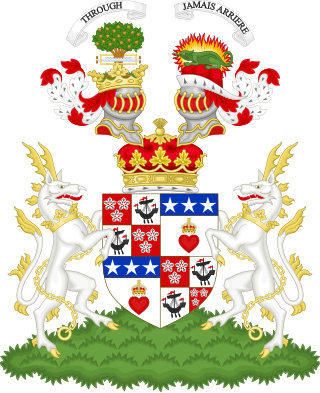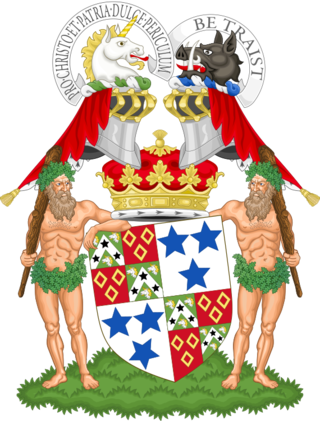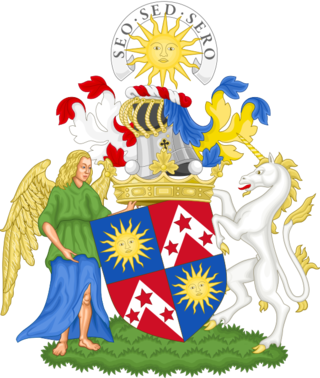Related Research Articles
Duke of Buckingham, referring to Buckingham, is an extinct title that has been created several times in the peerages of England, Great Britain, and the United Kingdom. There were creations of double dukedoms of Buckingham and Normanby and of Buckingham and Chandos. The last holder of the dukedom died in 1889.

Duke of Hamilton is a title in the Peerage of Scotland, created in April 1643. It is the senior dukedom in that peerage, and as such its holder is the premier peer of Scotland, as well as being head of both the House of Hamilton and the House of Douglas. The title, the town of Hamilton in Lanarkshire, and many places around the world are named after members of the Hamilton family. The ducal family's surname, originally "Hamilton", is now "Douglas-Hamilton". Since 1711, the dukedom has been held together with the Dukedom of Brandon in the Peerage of Great Britain, and the dukes since that time have been styled Duke of Hamilton and Brandon, along with several other subsidiary titles.

Duke of Somerset, from the county of Somerset, is a title that has been created five times in the peerage of England. It is particularly associated with two families: the Beauforts, who held the title from the creation of 1448, and the Seymours, from the creation of 1547, in whose name the title is still held. The present dukedom is unique, in that the first holder of the title created it for himself in his capacity of Lord Protector of the Kingdom of England, using a power granted in the will of his nephew King Edward VI.

[[File:|thumb|]] The Duke of Roxburghe is a title in the peerage of Scotland created in 1707 along with the titles Marquess of Bowmont and Cessford, Earl of Kelso and Viscount Broxmouth. John Ker, 5th Earl of Roxburghe became the first holder of these titles. The title is derived from the royal burgh of Roxburgh in the Scottish Borders that in 1460 the Scots captured and destroyed.

Duke of Atholl, named for Atholl in Scotland, is a title in the Peerage of Scotland held by the head of Clan Murray. It was created by Queen Anne in 1703 for John Murray, 2nd Marquess of Atholl, with a special remainder to the heir male of his father, the 1st Marquess.

Viscount Cobham is a title in the Peerage of Great Britain that was created in 1718. Owing to its special remainder, the title has passed through several families. Since 1889, it has been held by members of the Lyttelton family.

Marquess of Lothian is a title in the Peerage of Scotland, which was created in 1701 for Robert Kerr, 4th Earl of Lothian. The Marquess of Lothian holds the subsidiary titles of Earl of Lothian, Earl of Lothian, Earl of Ancram (1633), Earl of Ancram, Viscount of Briene (1701), Lord Newbattle (1591), Lord Jedburgh (1622), Lord Kerr of Newbattle (1631), Lord Kerr of Nisbet, Langnewtoun, and Dolphinstoun (1633), Lord Kerr of Newbattle, Oxnam, Jedburgh, Dolphinstoun and Nisbet (1701), and Baron Ker, of Kersheugh in the County of Roxburgh (1821), all but the last in the Peerage of Scotland. As The Lord Ker in the Peerage of the United Kingdom, previous marquesses sat in the House of Lords before 1963, when Scottish peers first sat in the House of Lords in their own right. The holder of the marquessate is also the Chief of Clan Kerr.

Earl of Perth is a title in the Peerage of Scotland. It was created in 1605 for James Drummond, 4th Lord Drummond. The Drummond family claim descent from Maurice, son of George, a younger son of King Andrew I of Hungary. Maurice arrived in Scotland on the ship which brought Edgar Ætheling, the Saxon claimant to the crown of England after the Norman Conquest, and his sister Margaret to Scotland in 1068. Maurice was given lands in Lennox (Dunbartonshire), together with the hereditary stewardship of the county. The Hungarian Prince theory has been discounted as no evidence of any relationships exists in written records or DNA. "The Red Book of the Menteiths" clearly discounts the Hungarian Prince as a myth likely formed to give status to the Drummond origins. The Drummonds in the 12th century were allied to the Menteiths – their early fortunes developed through the relationship. Indeed, one "Johannes De Drumon", said to have died in 1301, was buried in Inchmahome Priory which was founded by the Menteiths. His successor John Drummond, the 7th Steward, was deprived of the lands and retired into Perthshire.

Earl of Southesk is a title in the Peerage of Scotland. It was created in 1633 for Sir David Carnegie, an Extraordinary Lord of Session. He had already been created Lord Carnegie of Kinnaird in 1616 and was made Lord Carnegie, of Kinnaird and Leuchars, at the same time he was given the earldom. These titles are also in the Peerage of Scotland. The earldom is named after the River South Esk in Angus. Carnegie's younger brother John Carnegie was given the corresponding title: earl of Northesk. The earl of Southesk also holds the Scottish feudal title of Baron of Kinnaird and is a baronet in the Baronetage of Nova Scotia. Kinnaird Castle, Brechin, has been the home of the earls of Southesk for several hundred years.
Earl of March is a title that has been created several times, respectively, in the Peerage of Scotland and the Peerage of England. The title derives from the "marches" or borderlands between England and either Wales or Scotland, and it was held by several great feudal families which owned lands in those districts. Later, however, the title came to be granted as an honorary dignity, and ceased to carry any associated power in the marches.

Lord Herries of Terregles is a hereditary title in the Peerage of Scotland. It was created in 1490 for Herbert Herries with remainder to his heirs general.

John Ker, 3rd Duke of Roxburghe, KG, KT, PC was a Scottish peer, scholar and publisher.
Robert Ker, 1st Earl of Roxburghe was a Scottish nobleman.
William Ker, 2nd Earl of Roxburghe PC was a Scottish nobleman who inherited his title from his maternal grandfather, Robert Ker, 1st Earl of Roxburghe.

John Ker, 1st Duke of Roxburghe, KG, PC, FRS was a Scottish nobleman.
James Innes-Ker, 5th Duke of Roxburghe was a Scottish nobleman.
William Bellenden, Lord Bellenden PC, was Treasurer-depute of Scotland.
Robert Ker, 3rd Earl of Roxburghe PC was a Scottish nobleman.
William Bellenden-Ker, 7th Lord Bellenden, 4th Duke of Roxburghe was a Scottish nobleman.
John Bellenden, 2nd Lord Bellenden was a Scottish nobleman.
References
- 1 2 Lodge, Edmund (1832). The Genealogy of the Existing British Peerage: With Brief Sketches of the Family Histories of the Nobility. Saunders and Otley. p. 313.